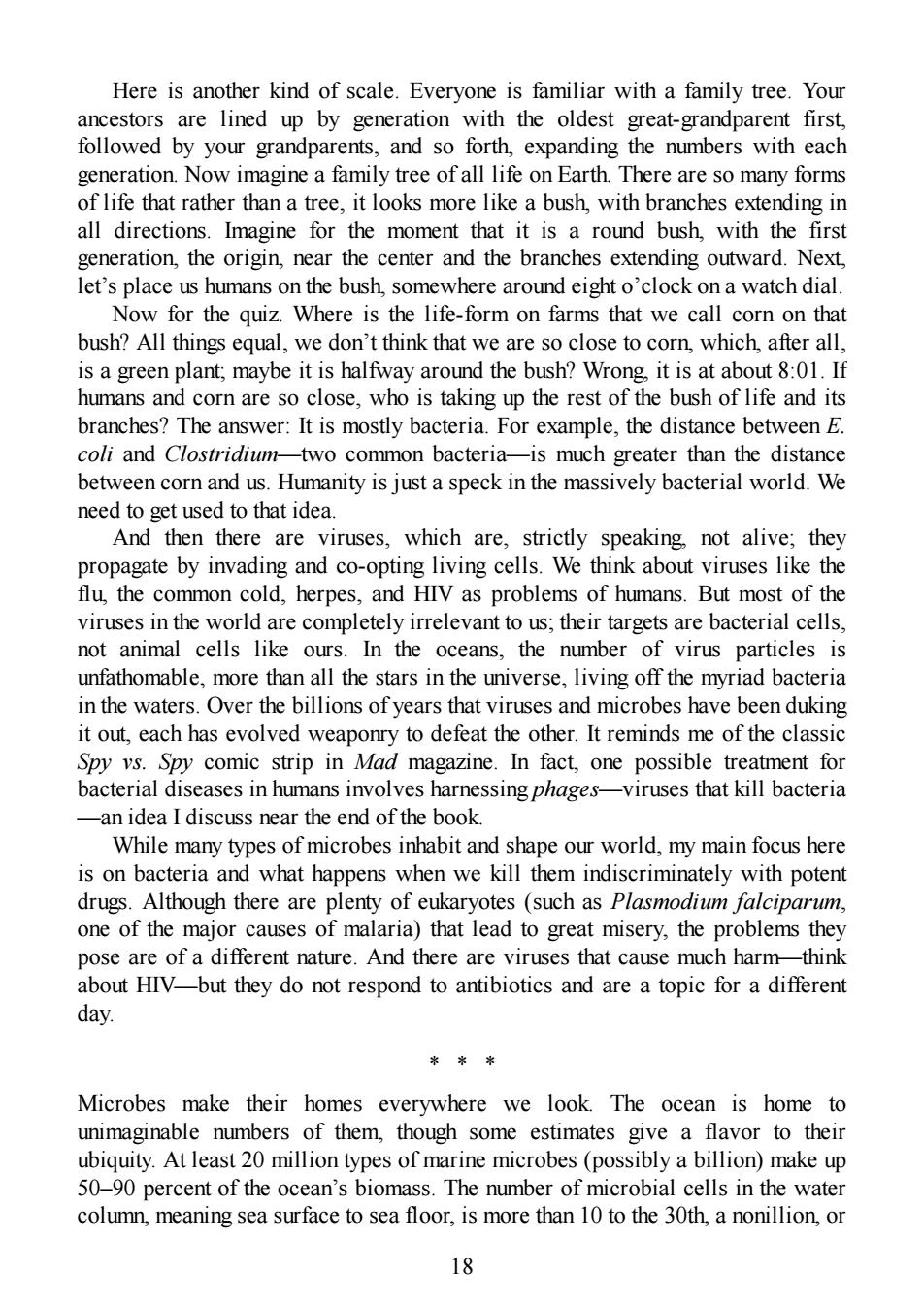正在加载图片...

Here is another kind of scale.Everyone is familiar with a family tree.Your ancestors are lined up by generation with the oldest great-grandparent first, followed by your grandparents,and so forth,expanding the numbers with each generation.Now imagine a family tree of all life on Earth.There are so many forms of life that rather than a tree,it looks more like a bush,with branches extending in all directions.Imagine for the moment that it is a round bush,with the first generation,the origin,near the center and the branches extending outward.Next, let's place us humans on the bush,somewhere around eight o'clock on a watch dial. Now for the quiz.Where is the life-form on farms that we call corn on that bush?All things equal,we don't think that we are so close to corn,which,after all, is a green plant maybe it is halfway around the bush?Wrong,it is at about 8:01.If humans and corn are so close,who is taking up the rest of the bush of life and its branches?The answer:It is mostly bacteria.For example,the distance between E. coli and Clostridium-two common bacteria-is much greater than the distance between corn and us.Humanity is just a speck in the massively bacterial world.We need to get used to that idea. And then there are viruses,which are,strictly speaking,not alive;they propagate by invading and co-opting living cells.We think about viruses like the flu,the common cold,herpes,and HIV as problems of humans.But most of the viruses in the world are completely irrelevant to us;their targets are bacterial cells, not animal cells like ours.In the oceans,the number of virus particles is unfathomable,more than all the stars in the universe,living off the myriad bacteria in the waters.Over the billions of years that viruses and microbes have been duking it out,each has evolved weaponry to defeat the other.It reminds me of the classic Spy vs.Spy comic strip in Mad magazine.In fact,one possible treatment for bacterial diseases in humans involves harnessing phages-viruses that kill bacteria -an idea I discuss near the end of the book While many types of microbes inhabit and shape our world,my main focus here is on bacteria and what happens when we kill them indiscriminately with potent drugs.Although there are plenty of eukaryotes (such as Plasmodium falciparum, one of the major causes of malaria)that lead to great misery,the problems they pose are of a different nature.And there are viruses that cause much harmthink about HIV-but they do not respond to antibiotics and are a topic for a different day Microbes make their homes everywhere we look.The ocean is home to unimaginable numbers of them,though some estimates give a flavor to their ubiquity.At least 20 million types of marine microbes(possibly a billion)make up 50-90 percent of the ocean's biomass.The number of microbial cells in the water column,meaning sea surface to sea floor,is more than 10 to the 30th,a nonillion,or 18Here is another kind of scale. Everyone is familiar with a family tree. Your ancestors are lined up by generation with the oldest great-grandparent first, followed by your grandparents, and so forth, expanding the numbers with each generation. Now imagine a family tree of all life on Earth. There are so many forms of life that rather than a tree, it looks more like a bush, with branches extending in all directions. Imagine for the moment that it is a round bush, with the first generation, the origin, near the center and the branches extending outward. Next, let’s place us humans on the bush, somewhere around eight o’clock on a watch dial. Now for the quiz. Where is the life-form on farms that we call corn on that bush? All things equal, we don’t think that we are so close to corn, which, after all, is a green plant; maybe it is halfway around the bush? Wrong, it is at about 8:01. If humans and corn are so close, who is taking up the rest of the bush of life and its branches? The answer: It is mostly bacteria. For example, the distance between E. coli and Clostridium—two common bacteria—is much greater than the distance between corn and us. Humanity is just a speck in the massively bacterial world. We need to get used to that idea. And then there are viruses, which are, strictly speaking, not alive; they propagate by invading and co-opting living cells. We think about viruses like the flu, the common cold, herpes, and HIV as problems of humans. But most of the viruses in the world are completely irrelevant to us; their targets are bacterial cells, not animal cells like ours. In the oceans, the number of virus particles is unfathomable, more than all the stars in the universe, living off the myriad bacteria in the waters. Over the billions of years that viruses and microbes have been duking it out, each has evolved weaponry to defeat the other. It reminds me of the classic Spy vs. Spy comic strip in Mad magazine. In fact, one possible treatment for bacterial diseases in humans involves harnessing phages—viruses that kill bacteria —an idea I discuss near the end of the book. While many types of microbes inhabit and shape our world, my main focus here is on bacteria and what happens when we kill them indiscriminately with potent drugs. Although there are plenty of eukaryotes (such as Plasmodium falciparum, one of the major causes of malaria) that lead to great misery, the problems they pose are of a different nature. And there are viruses that cause much harm—think about HIV—but they do not respond to antibiotics and are a topic for a different day. * * * Microbes make their homes everywhere we look. The ocean is home to unimaginable numbers of them, though some estimates give a flavor to their ubiquity. At least 20 million types of marine microbes (possibly a billion) make up 50–90 percent of the ocean’s biomass. The number of microbial cells in the water column, meaning sea surface to sea floor, is more than 10 to the 30th, a nonillion, or 18